

Emil Cioran. Romanian philosopher and essayist Emil Cioran (Romanian: [eˈmil t͡ʃoˈran] ( listen); 8 April 1911 – 20 June 1995) was a Romanian philosopher and essayist, who published works in both Romanian and French.

His work has been noted for its pervasive philosophical pessimism, and frequently engages with issues of suffering, decay, and nihilism. Kubbealti Lugati - paralojizm kelimesi anlamı, paralojizm nedir? Paralogism. Sefirot. Sefirot (; Hebrew: סְפִירוֹת səp̄îrôṯ), meaning emanations, are the 10 attributes/emanations in Kabbalah, through which Ein Sof (The Infinite) reveals Himself and continuously creates both the physical realm and the chain of higher metaphysical realms (Seder hishtalshelus).
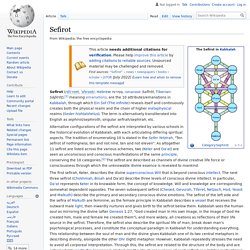
The term is alternatively transliterated into English as sephirot/sephiroth, singular sefirah/sephirah etc. Binah (Kabbalah) Third sephira on the kabbalistic Tree of Life Binah is 'intuitive understanding', or 'contemplation'.
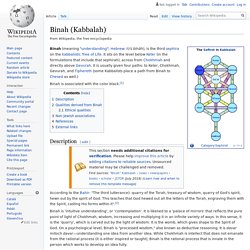
Notarikon. Temurah (Kabbalah) Temurah (Hebrew: תְּמוּרָה) is one of the three ancient methods used by Kabbalists to rearrange words and sentences in the Bible, in the belief that by this method they can derive the esoteric substratum and deeper spiritual meaning of the words.

(The others are Gematria and Notarikon.) Temurah may be used to change letters in certain words to create a new meaning for a Biblical statement. Temurah (Kabbalah) Gematria. Assigning a numerical value to a name, word or phrase based on its letters Gematria (; Hebrew: גמטריא or Gimatria גימטריה, plural גמטראות or גמטריאות, gematriot)[1] is an alphanumeric code of assigning a numerical value to a name, word or phrase based on its letters.

A single word can yield multiple values depending on the cipher used. Gematria originated as an Assyro-Babylonian-Greek system of alphanumeric code or cipher that was later adopted into Jewish culture. [dubious ] Similar systems have been used in other languages and cultures: earlier, the Greek isopsephy, and later, derived from or inspired by Hebrew gematria, Arabic abjad numerals, and English gematria.
Etymology[edit] Although the term is Hebrew, it may be derived from the Greek γεωμετρία geōmetriā, "geometry", which was used as a translation of gēmaṭriyā, though some scholars believe it to derive from Greek γραμματεια grammateia "knowledge of writing". Rosicrucian Fellowship. Abraham Abulafia. Abraham ben Samuel Abulafia (Hebrew: אברהם בן שמואל אבולעפיה) was the founder of the school of "Prophetic Kabbalah".
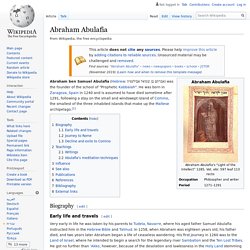
He was born in Zaragoza, Spain in 1240 and is assumed to have died sometime after 1291, following a stay on the small and windswept island of Comino, the smallest of the three inhabited islands that make up the Maltese archipelago.[1] Biography[edit] Early life and travels[edit] Although he always held Maimonides in the highest esteem, and often made use of sentences from his writings, he was as little satisfied with his philosophy as with any other branch of knowledge which he acquired. He was highly articulate, able and eager to teach others. Journey to Rome[edit] He went to Rome in 1280 in order to convert Pope Nicholas III to Judaism on the day before Rosh Hashanah. Decline and exile to Comino[edit] He remained active in Messina for a decade (1281–91), presenting himself as a "prophet" and "messiah".
Tikkun. Tikkun/Tikun (תיקון) is a Hebrew word meaning "Fixing/Rectification".

It has several connotations in Judaism: Traditional: Contemporary: Tsimtsun. Balneum Mariae. Mysterium conjunctionis. Aeolipile. An illustration of Hero's aeolipile An aeolipile (or aeolipyle, or eolipile), also known as a Hero's engine, is a simple, bladeless radial steam turbine which spins when the central water container is heated.
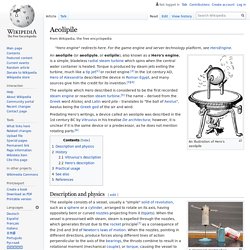
Torque is produced by steam jets exiting the turbine, much like a tip jet[1] or rocket engine.[2] In the 1st century AD, Hero of Alexandria described the device in Roman Egypt, and many sources give him the credit for its invention.[3][4] The aeolipile which Hero described is considered to be the first recorded steam engine or reaction steam turbine.[5] The name – derived from the Greek word Αἴολος and Latin word pila – translates to "the ball of Aeolus", Aeolus being the Greek god of the air and wind. Predating Hero's writings, a device called an aeolipile was described in the 1st century BC by Vitruvius in his treatise De architectura; however, it is unclear if it is the same device or a predecessor, as he does not mention rotating parts.[6]
Dufaux triplane. The so-called Dufaux triplane[citation needed] was an unnamed experimental aircraft built in Switzerland in 1908.
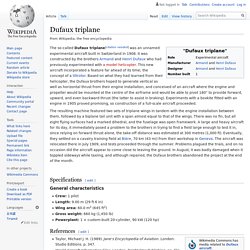
It was constructed by the brothers Armand and Henri Dufaux who had previously experimented with a model helicopter. This new aircraft incorporated a feature far ahead of its time; the concept of a tiltrotor. Based on what they had learned from their helicopter, the Dufaux brothers hoped to generate vertical as well as horizontal thrust from their engine installation, and conceived of an aircraft where the engine and propeller would be mounted at the centre of the airframe and would be able to pivot 180° to provide forward, upward, and even backward thrust (the latter to assist in braking). Experiments with a boxkite fitted with an engine in 1905 proved promising, so construction of a full-scale aircraft proceeded.
Specifications[edit] General characteristics References[edit] Taylor, Michael J. File:Foucault's pendelum swings in the Priory of Saint-Martin-des-Champs, Paris 2 July 2015.jpg. Ein-Sof. Heraclitus. Pre-Socratic Greek philosopher.
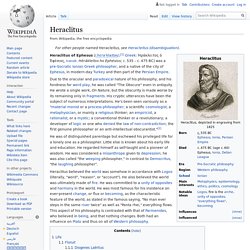
Semiotics. The study of signs and sign processes Semiotics is frequently seen as having important anthropological and sociological dimensions; for example, the Italian semiotician and novelist Umberto Eco proposed that every cultural phenomenon may be studied as communication.[1] Some semioticians focus on the logical dimensions of the science, however.
They examine areas belonging also to the life sciences—such as how organisms make predictions about, and adapt to, their semiotic niche in the world (see semiosis). In general, semiotic theories take signs or sign systems as their object of study: the communication of information in living organisms is covered in biosemiotics (including zoosemiotics and phytosemiotics). Semiotics is not to be confused with the Saussurean tradition called semiology, which is a subset of semiotics.[2][3] Terminology[edit] Charles W.